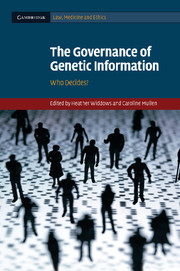Book contents
- Frontmatter
- Contents
- Notes on contributors
- Preface
- Introduction
- SECTION I Problematising governance of genetic information
- 1 The medium and the message: tissue samples, genetic information and data protection legislation
- 2 Me, myself, I – against narcissism in the governance of genetic information
- 3 Decisions, consent and expectations of the individual
- SECTION II Ethical frameworks of governance
- SECTION III Redesigning governance
- Bibliography
- Index
1 - The medium and the message: tissue samples, genetic information and data protection legislation
Published online by Cambridge University Press: 02 February 2010
- Frontmatter
- Contents
- Notes on contributors
- Preface
- Introduction
- SECTION I Problematising governance of genetic information
- 1 The medium and the message: tissue samples, genetic information and data protection legislation
- 2 Me, myself, I – against narcissism in the governance of genetic information
- 3 Decisions, consent and expectations of the individual
- SECTION II Ethical frameworks of governance
- SECTION III Redesigning governance
- Bibliography
- Index
Summary
There are many ethical, legal and regulatory issues surrounding the acquisition, possession and use of genetic information. But what is genetic information, and why and when do such issues arise? Here the aim is to provide something by way of an answer to these questions, and I will do so by focusing on whether certain regulatory instruments that apply to the use of personal information ought to apply to archives or collections of human tissues, in so far as such samples – including blocks, slides and other artefacts – contain genetic information.
Human tissue samples are acquired and stored for a variety of good reasons: for example, as part of a process of individual diagnosis, or as part of a forensic investigation or autopsy. Samples may also be taken and stored for teaching and training purposes, or as part of clinical audit and performance assessment, and so on. In the UK – which is to be our focus – actions involving human tissue fall under the regulatory scope of the Human Tissue Act 2004 (HTA04). But most human tissue samples contain genetic material and genetic material is standardly assumed to contain genetic information, including personal information about the source of the tissue: information about their current or future state of health, for example. In the UK the legal instrument that pertains to the storage and use of personal information is the Data Protection Act 1998 (DPA98). DPA98 specifies a range of obligations upon those responsible – typically in institutions – for the acquisition, storage or use of certain types of information.
- Type
- Chapter
- Information
- The Governance of Genetic InformationWho Decides?, pp. 15 - 36Publisher: Cambridge University PressPrint publication year: 2009
- 5
- Cited by



